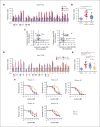Conflict-of-interest disclosure: M.K. reports grants and/or other from AbbVie, F. Hoffman La-Roche, Stemline Therapeutics, Forty-Seven, Eli Lilly, Cellectis, Calithera, Ablynx, Agios, Ascentage, AstraZeneca, Reata Pharmaceutical, Rafael Pharmaceutical, Sanofi, Janssen, and Genentech. A.L. reports consultation and research support from AbbVie, Novartis, and AstraZeneca, and is an equity-holding member of the scientific advisory boards of Zentalis Pharmaceuticals, Flash Therapeutics, and Dialectic Therapeutics. J.S.G. received research funding from AbbVie, Genentech, Prelude, AstraZeneca, and Pfizer, and served on advisory boards for AbbVie, Genentech, Bristol Myers Squibb, and Servier. M.O. has served on advisory boards for Amgen, Pfizer, Janssen, and Bristol Myers Squibb. The remaining authors declare no competing financial interests.




